Sailboat maintenance and refitting often involves many difficult, frustrating jobs – diesel engine work, rigging, fiberglassing, boatyard work. So it’s really nice to have some easy, fun ones mixed in sometimes. If you only did hard projects all the time, you’d probably burn out.
Easy projects are short, cheap and rewarding because they quickly make some small improvement to your life. They’re simple enough that unlike most boat projects, there aren’t 10 different things that can go wrong.
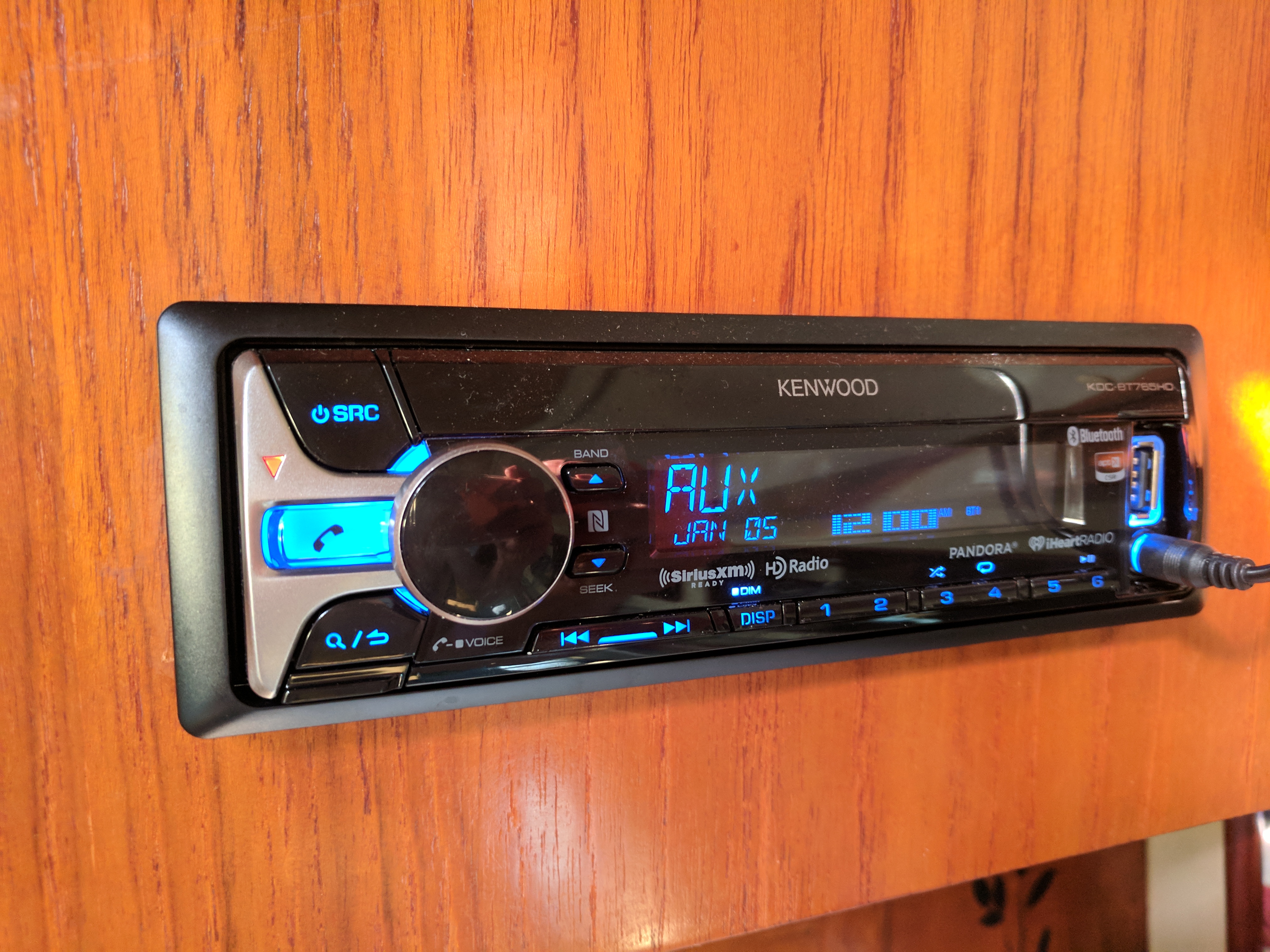
Ice Box LED Light
The first one, which I should’ve done a long time ago, is add a light to our fridge / ice box.
You see, our ice box is a great, giant, cavernous hole in which my beers sit at the bottom in the dark. So last summer when I wanted to find a beer, I’d often have to grab my headlamp or handy pocket flashlight. As everyone knows, beer is important to sailors. And often when cruising BC, we had a variety of types to try (Lighthouse IPA, Red Racer, Russell Brewing’s mixer pack, etc), so I couldn’t just grab any blindly.
Finally I realized a cheap solution to this inconvenience: motion activated LED light bars which you can find on Amazon for about $10! And this one came with a 3M adhesive strip on the back, so all I had to do was stick it on a surface inside the icebox.
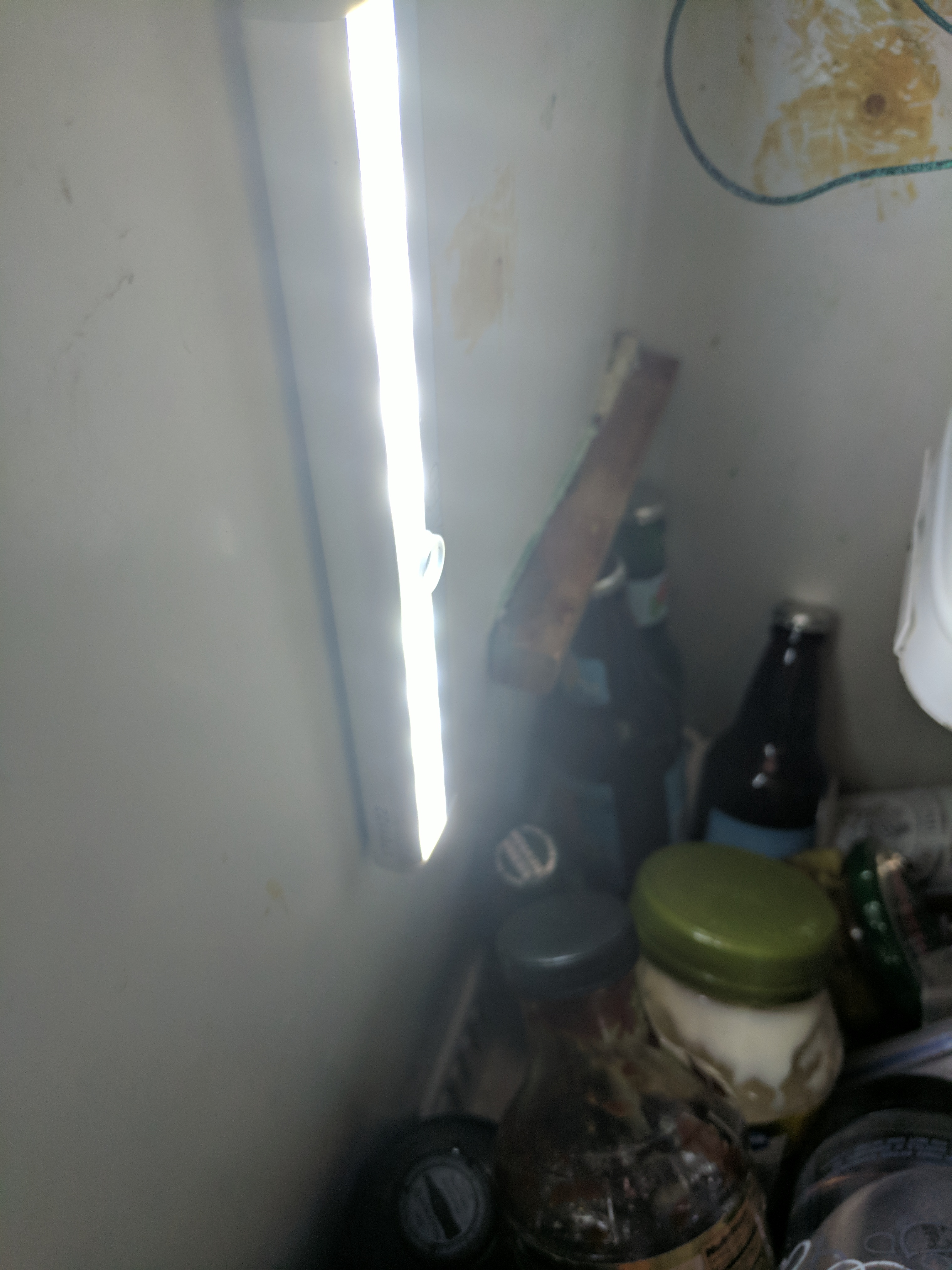
Sure, the moisture in there will eventually corrode the battery contacts or something. But for $10 I can just buy a new one when that happens. And the light has a magnetic back which makes it easy to quickly detach. The batteries last about 3 months. But I can use my rechargeable Eneloops to save some money and reduce recycling.
Radio
Our boat has a FM/AM radio with 6-disc CD changer and cassette tape slot. Yes, you read that right, a cassette tape! Remember those things? They’re so far antiquated that we might as well have a record player and a morse code machine. How about a Loran too while we’re at it?
Now there’s nothing wrong with the radio – we just ignore the cassette slot and use FM radio or CDs (yes, we still have some CDs!). But the radio doesn’t have a USB input or even an audio jack input, which would allow us to use phones – where most of our music is (downloaded + Pandora). On occasion we’ve used a tiny portable speaker but it doesn’t produce as much sound as the boat’s speakers.
This wasn’t a priority before, and it’s hard to justify spending time + money on such a trivial problem. But now that we have 2 years worth of safety + livability improvements mostly out of the way (here’s the list from just the first year), we can do fun little projects like this.
The thing I didn’t realize is: because these radio faceplates / receivers are used for *cars*, they’re really cheap! No marine tax. And they’re standardized, unlike most marine stuff! (a single DIN radio refers to the dimensions, which are made to a standard specification so you can buy any single DIN radio and it’ll fit).
Pretty much every radio made today comes with a USB input and audio jack input, but there are many other options available, which makes choosing one a bit confusing: Bluetooth, HD radio, Sirius XM radio, apps for Pandora and Spotify, etc.
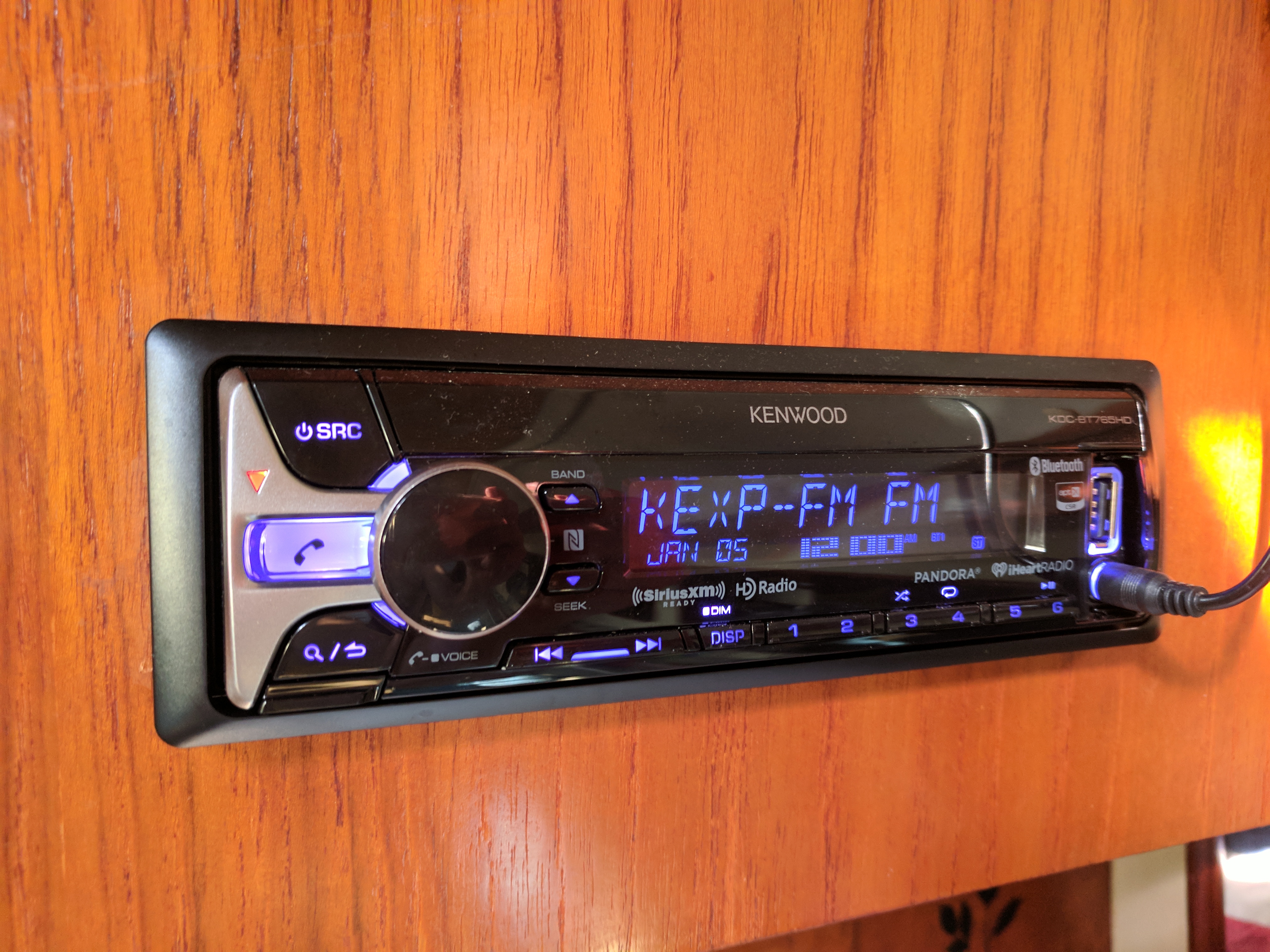
I settled on the Kenwood KDC-BT765HD receiver with Bluetooth, USB, audio jack, CD slot, HD radio, and remote control. Installation was pretty straightforward, but the new radio didn’t use the same wiring harness as the old one, so I had to do some rewiring using butt connectors to join about 10 wires.
The Bluetooth doesn’t work that well – it loses reception and the music skips if I’m walking around with my phone or it’s more than 10’ away. So we end up using the little remote control more, and I’m glad I got one with that feature. It’s handy when you want to adjust the volume from the cockpit.
We’ve found while sailing the west coast of Van Isle and the Inside Passage that music is really important for keeping morale up and staving off loneliness.
Propane tank grill adapter
This project was simply adding a 3-way valve to our boat’s propane tank and a gas line running that to our BBQ grill on the stern.
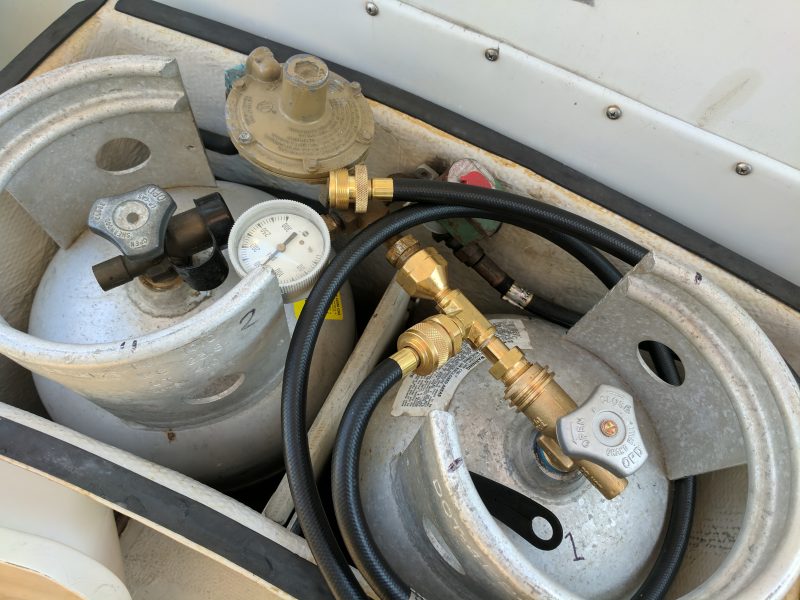
This is an idea I saw another cruiser implement, and I had dismissed it as an unnecessary use of time and money for relatively low benefit. But now that we’re living on our boat, and grilling a lot, the equation changed. It really doesn’t take much time – about 15 minutes – and the cost was about $70.
The main benefit is no more 1 lb disposable propane cylinders! Not only are those propane cylinders expensive (even on sale they’re usually $4/each), but they’re wasteful – we go through 2-3/month in the summer and have to throw them out. Furthermore, if we’re cruising for 3 months like in 2016, stocking up on 6 to 8 propane cylinders makes them a pain to store – storage space on a boat is always at a premium.
I bought the valve and adapter line at Sure Marine, our local marine heating business. I probably could’ve gotten it cheaper online, but I wanted to support a friendly, helpful local business.
The gas line is a high pressure line (it goes before the boat’s LPG regulator) so it’s important to put it away in the propane box when not using the grill. The 3-way valve is so we don’t have to disconnect the boat’s LPG every time we grill.
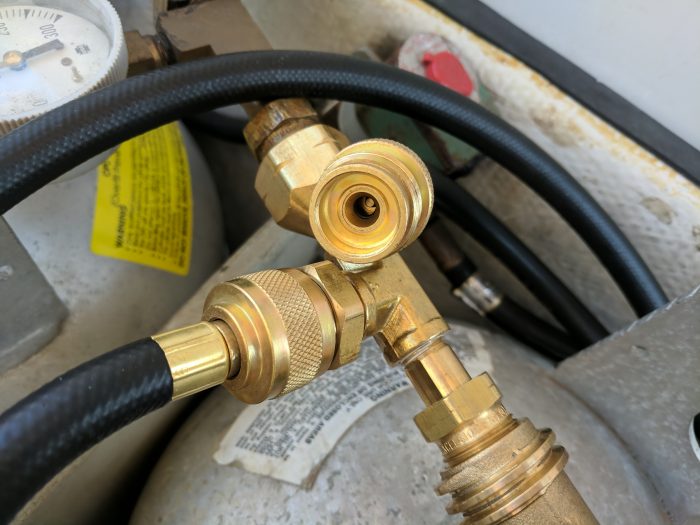
August is No Time for Cruising
On a different note, this August has been a really weird weather month. Not only has it been pretty windless – common for Seattle in August – it’s been so sunny and dry this summer (like 68 rain-free days out of 70) that Washington and BC have broken out into forest fires.
Weather forecasts have been “hot and smoky with a chance of falling ash.” Our normally amazing views of Mount Rainier, the Cascades and Olympics have been completely obscured by a smog-like sky. The air feels difficult to breathe.
So I’ve been pretty glad to be tied to the dock rather than motoring around in the heat and oppressive smoke layer. I have a theory that August is the worst month for cruising in the Seattle area (if you’re a sailor; for motorboaters it’s fine). Yet August is one of the most popular cruising months, and many sailors delay their plans until that month. Strange.
Yes, occasionally there’s a windy day, and often there’s 10-12 knots for 3-4 hours in the evening. But evening wind is best for evening sails out-and-back from the marina. Watching the West Point NOAA buoy history confirms that many days in a row have a mere whisper of a breeze.
Last year we were cruising in August (where we spent some of it Windless in the South Sound) but next year we’ll aim to be done cruising before then and just chill for the month of August. Then when September rolls around perhaps we’ll cruise some more, because September is when most of the boats go home, and the wind comes back, yet it’s still warm.
Concluding
These three projects reminded me sometimes it’s the simple things that are the most rewarding. Are there any quick, cheap projects you’ve found that improved your life onboard?

Always so many jobs to do isn’t there! I’ve just got a new rigging wire, new blocks and lines on the mainsheet, new outhaul and new topping lift and a new masthead light. Haven’t got the bill yet… dread to think how much it is going to cost! Eeeek!
That lightstrip is a great idea! Does using the engine cause it to turn on with the vibration?
Nope. The light bar is motion activated. Opening the lid or reaching a hand in near it activates it. No issues with false activations afaik.
I picked the same stereo to replace the oldie on S V Pinga. However, whenever that switched circuit powers on, the radio powers up…. after that I turn it back off or on at the radio SRC button. But a car radio has to be switched on initially using the radio’s buttons, so any clue what’s wrong? Just wondering. We use its USB plug for charging, also mini-fan, reading mini-spotlight, etc.
Weird, mine doesn’t have that issue. My best guess is I suspect you wired the ignition wire and battery wires of the radio differently.
Install diagram, page 31: http://manual.kenwood.com/files/B5A-0889-00.pdf
Basically the battery wire (yellow) is for an “always on” power source to preserve memory state. Ignition wire (red) is typically wired to the cars ignition (switch, requiring the car to be ON / ACC for radio to be used). Since I didn’t want to run an “always on” power source to the radio, I just connected the red (ignition) wire to house positive. Perhaps you have it the reverse.
Incidentally, I was concerned about losing radio memory (saved stations, clock) so I did some research to try to find radios that have solid state memory or an internal battery. I found a couple expensive, marine radios that advertised this feature. But, this Kenwood radio hasn’t lost clock/station memory yet despite having no always-on power, so I suspect it has some kind of memory saving feature that wasn’t listed in the specs.